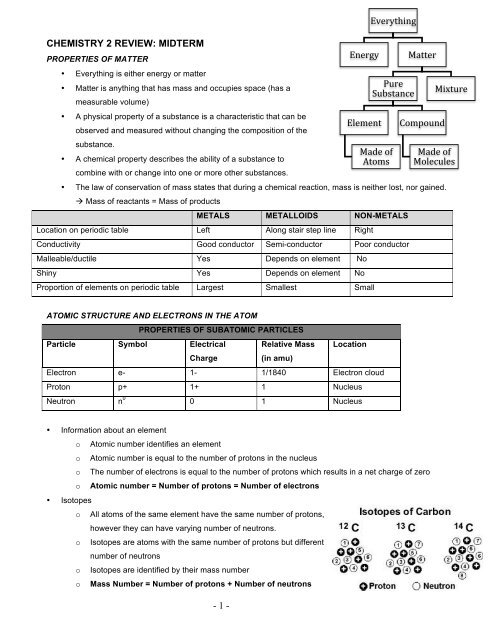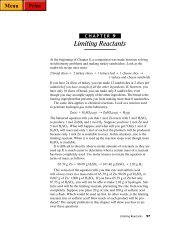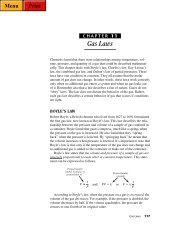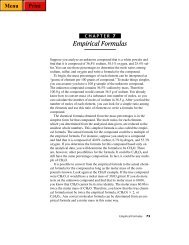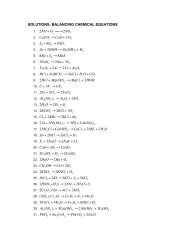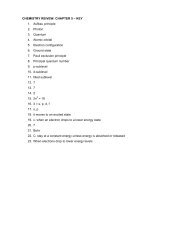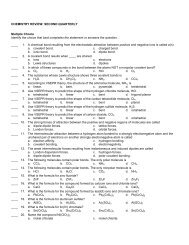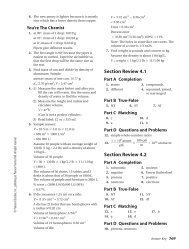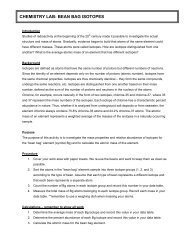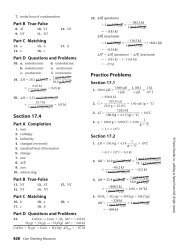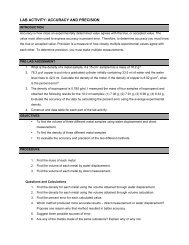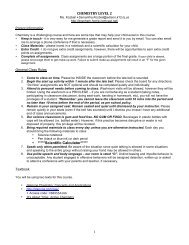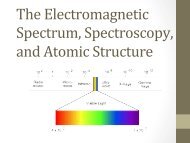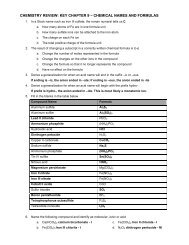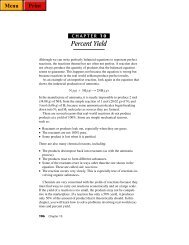- 1 - CHEMISTRY 2 REVIEW: MIDTERM Everything Energy Matter ...
- 1 - CHEMISTRY 2 REVIEW: MIDTERM Everything Energy Matter ...
- 1 - CHEMISTRY 2 REVIEW: MIDTERM Everything Energy Matter ...
Create successful ePaper yourself
Turn your PDF publications into a flip-book with our unique Google optimized e-Paper software.
<strong>CHEMISTRY</strong> 2 <strong>REVIEW</strong>: <strong>MIDTERM</strong><br />
PROPERTIES OF MATTER<br />
• <strong>Everything</strong> is either energy or matter<br />
• <strong>Matter</strong> is anything that has mass and occupies space (has a<br />
measurable volume)<br />
• A physical property of a substance is a characteristic that can be<br />
observed and measured without changing the composition of the<br />
substance.<br />
• A chemical property describes the ability of a substance to<br />
combine with or change into one or more other substances.<br />
• The law of conservation of mass states that during a chemical reaction, mass is neither lost, nor gained.<br />
à Mass of reactants = Mass of products<br />
METALS METALLOIDS NON-METALS<br />
Location on periodic table Left Along stair step line Right<br />
Conductivity Good conductor Semi-conductor Poor conductor<br />
Malleable/ductile Yes Depends on element No<br />
Shiny Yes Depends on element No<br />
Proportion of elements on periodic table Largest Smallest Small<br />
ATOMIC STRUCTURE AND ELECTRONS IN THE ATOM<br />
PROPERTIES OF SUBATOMIC PARTICLES<br />
Particle Symbol Electrical<br />
Charge<br />
- 1 -<br />
Relative Mass<br />
(in amu)<br />
Location<br />
Electron e- 1- 1/1840 Electron cloud<br />
Proton p+ 1+ 1 Nucleus<br />
Neutron n 0<br />
• Information about an element<br />
• Isotopes<br />
o Atomic number identifies an element<br />
0 1 Nucleus<br />
o Atomic number is equal to the number of protons in the nucleus<br />
o The number of electrons is equal to the number of protons which results in a net charge of zero<br />
o Atomic number = Number of protons = Number of electrons<br />
o All atoms of the same element have the same number of protons,<br />
however they can have varying number of neutrons.<br />
o Isotopes are atoms with the same number of protons but different<br />
number of neutrons<br />
o Isotopes are identified by their mass number<br />
o Mass Number = Number of protons + Number of neutrons<br />
<strong>Everything</strong><br />
<strong>Energy</strong> <strong>Matter</strong><br />
Element<br />
Pure<br />
Substance<br />
Made of<br />
Atoms<br />
Compound<br />
Mixture<br />
Made of<br />
Molecules
Bonding: Ionic vs. Molecular<br />
• Valence electrons are the electrons in the highest occupied energy level of an atom.<br />
• The number of valence electrons for a representative element is equal to the last number of its group<br />
number. Example: phosphorus is in group 15 – it has 5 valence electrons.<br />
• The octet rule: atoms tend to gain, lose or share electrons in order to have the electron configuration of<br />
•<br />
a noble gas<br />
Chemical Names and Formulas<br />
§ Ionic Compounds<br />
o Commonly a metal + nonmetal<br />
o Cation + anion<br />
o Combine in a ratio so that the net charge is zero<br />
o Use criss-cross method to write formula<br />
§ Naming an ionic compound from a formula<br />
o Name of cation + name of anion<br />
o Example Al2O3 = aluminum oxide<br />
§ Molecular Compounds<br />
o Commonly two non-metals<br />
o Name from formula for binary compound<br />
§ Element 1: Prefix (if subscript > 1) +<br />
name of element<br />
§ Element 2: prefix + stem of name + -ide<br />
§ Example: N2O5 = dinitrogen pentoxide<br />
1 Mono 6 Hexa<br />
2 Di 7 Hepta<br />
3 Tri 8 Octa<br />
4 Tetra 9 Nona<br />
5 Penta 10 Deca<br />
- 2 -<br />
CATIONS ANIONS<br />
Form from metals Form from non-metals<br />
Lose electrons Gain electrons<br />
Positively charged Negatively charged<br />
Charge = #electrons<br />
lost<br />
Type of<br />
elements<br />
IONIC<br />
Charge = # electrons<br />
lost<br />
COMPOUNDS<br />
MOLECULAR<br />
COMPOUNDS<br />
Metal + non-metal Non-metals only<br />
Type of bond Ionic bond Covalent bond<br />
Origin of<br />
bonding<br />
Smallest<br />
particles<br />
Transfer of<br />
electrons<br />
Sharing of<br />
electrons<br />
Ions Molecules
Chemical Reactions<br />
§ Chemical equations are always written<br />
o Reactants à products<br />
o Multiple reactants or products are separated with “+” signs<br />
§ Balancing equations<br />
o Equations are balanced by using coefficients to show the relative amounts of each reactant and<br />
product.<br />
o NEVER change the formulas<br />
o Make sure there are the same number of atoms of each type on both sides of the equation.<br />
o This is because of the law of conservation of mass – matter is neither created or destroyed<br />
TRENDS OF THE PERIODIC TABLE<br />
• Atomic radius – size of atom: increases down a group, decreases across a period<br />
Elements in same period have same<br />
number of energy levels<br />
Atomic radius decreases from left to<br />
right across a period<br />
Electromagnetic Spectrum<br />
- 3 -<br />
Elements in same group have same<br />
number of valence electrons<br />
Atomic radius increases from top to<br />
bottom in a group<br />
From lowest to highest energy<br />
1. Radio waves<br />
2. Microwaves<br />
3. Infrared<br />
4. Visible light<br />
5. Ultraviolet<br />
6. X-rays<br />
7. Gamma rays
Flame Test<br />
• A flame test can be used to identify a METAL.<br />
• An electron falling from an excited state will release energy in the<br />
form of colored light.<br />
• The color of the light depends upon the energy of the transition.<br />
o Red – lowest energy<br />
o Violet – highest energy<br />
Counting Atoms<br />
1. The symbol of an element represents 1 atom<br />
Example: Na = 1 atom of sodium<br />
2. A subscript indicates the number of atoms of a particular<br />
element<br />
Gas<br />
Example: H2 = 2 atoms of hydrogen<br />
3. A subscript outside of parentheses multiplies all elements<br />
inside the parentheses<br />
Example: Al(OH)3 = 1 aluminum, 3 oxygen, 3 hydrogen<br />
4. A coefficient in front of a symbol indicates the number of<br />
that element<br />
Liquid<br />
Example: 3 C = 3 atoms of carbon<br />
5. A coefficient in front of a chemical formula indicates the number of molecules of that compound and<br />
multiplies the number of atoms of each element in the formula<br />
Example: 3 N2O4 = 3 molecules or 6 atoms of nitrogen, 12 atoms of oxygen<br />
- 4 -<br />
Solid


